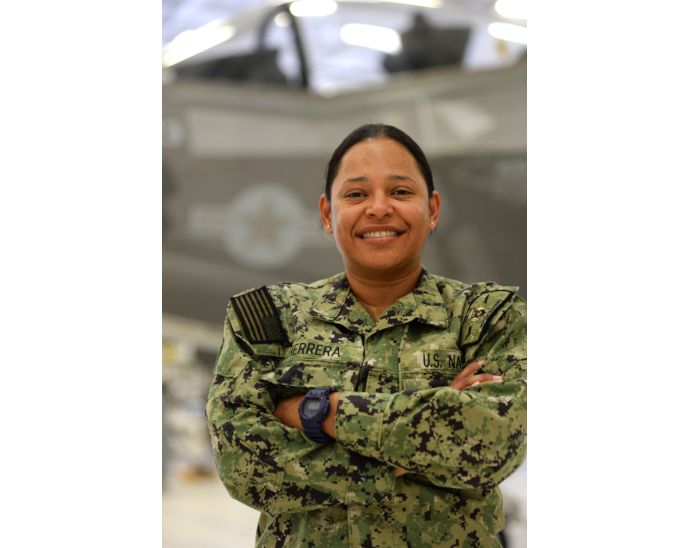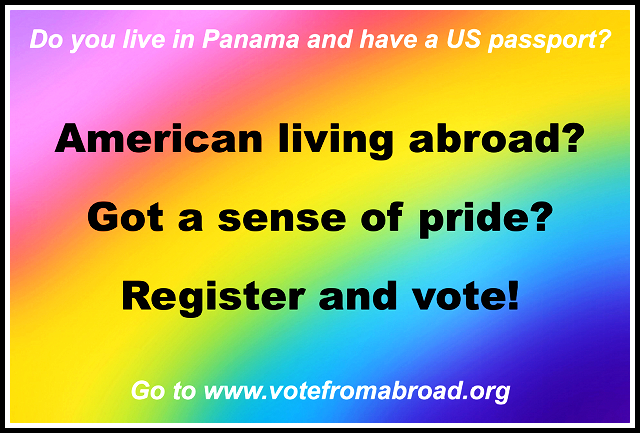Seaman Carmen Herrera. Photo by Mass Communication Specialist 1st Class Vanessa White, US Navy.
Sailor from Panama serves with a joint strike fighter
squadron from the US Navy’s largest master jet base
by Mass Communication Specialist 3rd Class Jerome Fjeld – US Navy
Seaman Carmen Herrera, a sailor from Macaracas, Panama, serves the US Navy assigned to Strike Fighter Squadron (VFA) 125. The command is a joint strike fighter squadron located aboard the US Navy’s largest master jet base in Lemoore, California.
Herrera joined the Navy two years ago. Today, Herrera serves as a legalman.
“I joined the Navy after I lost my job during the COVID-19 pandemic,” said Herrera. “After that, I decided I wanted to change my career path, and I ended up finding a job that allows me to show my gratitude to the country that I love.”
Growing up in Macaracas, Herrera attended Chupá High School and graduated in 1999. Today, Herrera relies upon skills and values similar to those found in Macaracas to succeed in the military.
“The work ethic I possess today stems from my upbringing on a farm, where I labored alongside my father,” said Herrera. “The daily toil and responsibility of farm work instilled in me a sense of resilience and fortitude, both mentally and physically.”
These lessons have helped Herrera while serving with the Navy.
Members of VFA 125 fly and maintain the F35-C Lightning II, a combat-ready fifth-generation fighter.
According to Navy officials, the F-35C is designed with the entire battlespace in mind, bringing transformational capability to the United States and its allies. Missions traditionally performed by specialized aircraft (air-to-air combat, air-to-ground strikes, electronic attack, intelligence, surveillance and reconnaissance) can now be executed by a squadron of F-35s.
For the first time in US naval aviation history, radar-evading stealth capability comes to the aircraft carrier deck. The F-35C carrier variant sets new standards in weapon system integration, lethality, maintainability, combat radius and payload that bring true multi-mission power projection capability from the sea, according to Navy officials.
This year commemorates 50 years of women flying in the US Navy. In 1973, the first eight women began flight school in Pensacola; one year later six of them, known as “The First Six,” earned their “Wings of Gold.” Over the past 50 years, the Navy has expanded its roles for women to lead and serve globally and today our women aviators project power from the sea in every type of Navy, Marine Corps, and Coast Guard aircraft. Our Nation and our Navy is stronger because of their service.
With 90 percent of global commerce traveling by sea and access to the internet relying on the security of undersea fiber optic cables, Navy officials continue to emphasize that the prosperity of the United States is directly linked to trained sailors and a strong Navy.
“Our mission remains timeless — to provide our fellow citizens with nothing less than the very best Navy: fully combat ready at all times, focused on warfighting excellence, and committed to superior leadership at every single level,” said Admiral Mike Gilday, Chief of Naval Operations. “This is our calling. And I cannot imagine a calling more worthy.”
As a member of the Navy, Herrera is part of a world-class organization focused on maintaining maritime dominance, strengthening partnerships, increasing competitive warfighting capabilities and sustaining combat-ready forces in support of the National Defense Strategy.
“The Navy is important because we protect the seas,” said Herrera. “We are not just defending ourselves but our allies as well.”
Herrera and the sailors they serve with have many opportunities to achieve accomplishments during their military service.
“I’m proud that I’m getting to change my job to legalman,” said Herrera. “I’m finally getting the career I’ve always wanted in the Navy.”
As Herrera and other sailors continue to train and perform missions, they take pride in serving their country in the United States Navy.
“Service means a lot to me,” said Herrera. “I’m very proud to serve this beautiful nation. I get to be courageous. This is my country. We enable freedom everywhere, we are not just protecting the United States. Wearing this uniform every day fills me with immense pride, and I strive to fulfill my duties with utmost dedication and excellence.”
“I would say to the people in Chicago and Panama that this is the greatest decision I’ve made,” said Herrera. “It feels great to be in the service, and I’m happy to do this job.”
Herrera is grateful to others for making a career in the Navy possible.
“I would like to thank my friends, Norman Francis and Tovy Knight,” added Herrera. “They helped me through the process of joining the military.”
Editor’s note: The relationships among the US Armed Forces, Panama and Panamanians have a long history, with changes along the way. It used to be that non-US citizens who worked for the Panama Canal, or the US military bases here, or their children, could enlist in the US forces from Panama. The only other country that had such an arrangement was The Philippines. No longer, however. You generally must be a US citizen or a US resident alien — holder of a green card — to join the US Armed Forces now.
There are large Panamanian-American communities in the USA that by and large trace roots to people becoming US citizens through military service and then moving after their service to places like Brooklyn, the Baltimore / DC / Northern Virginia area, Sacramento, Houston and elsewhere, then sponsoring relatives to immigrate to the States afterward. So much of US policy in this regard can be linked to the attitudes of this American army officer who was stationed in Panama after World War I and is said to have learned to be an executive while here. They called him Ike and he went on to greater responsibilities.
These days, Panamanians who are also Americans by way of having a US citizen parent who lived for a minimum number of years in the USA might still be eligible to join the US Navy. Better to ask a legalman like Seaman Herrera if you think that you are in that situation and are considering enlistment.
Contact us by email at fund4thepanamanews@gmail.com
To fend off hackers, organized trolls and other online vandalism, our website comments feature is switched off. Instead, come to our Facebook page to join in the discussion.
These links are interactive — click on the boxes












